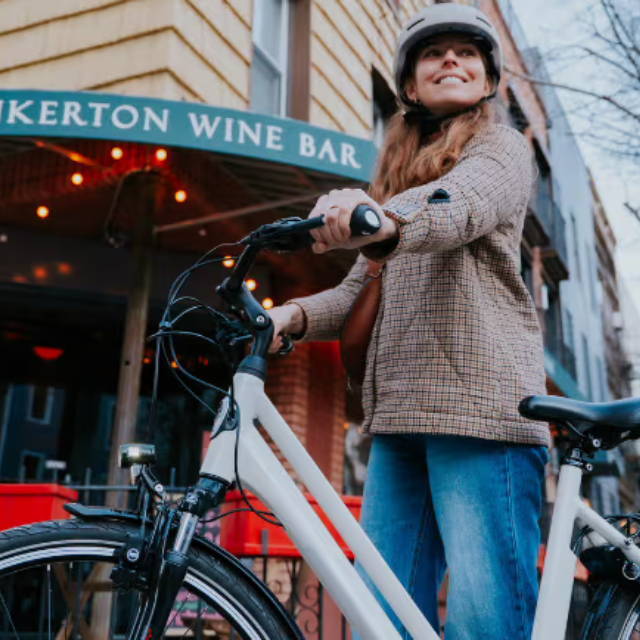A good-quality electric bike usually costs between $2,000 and $4,000 at retail, though premium models can run much higher. At Upway, you can find both new and pre-owned e-Bikes from leading brands—often at discounts of up to 60%!
E-Bike Cultures: From Tokyo Mamacharis to Dutch Bakfiets
Written by: Rémy Rossi | May 28, 2025 | Time to read 6 min
Not all e-Bikes are created equal— what works in Tokyo might look out of place in Texas. From Dutch bakfiets to throttle-happy cruisers, bike culture is as local as it gets.

More about the Author: Remy Rossi
Rémy Rossi is a bike writer, mechanic, and educator who got his start in community-based bike shops and co-ops. With a decade in the industry, he still wrenches on bikes when he can and plays bike polo on a fixie.

👋 Do you know Upway?
What shapes e-Bike design and culture?

Different cultures have different flavors of bicycles and e-Bikes, too. The flat terrain of the Netherlands gave way to the clunky yet comfortable Dutch-style cruisers, for example. Densely populated urban areas like Tokyo have super functional bikes loaded with child seats and baskets. And the wider roads and faster car traffic of the US likely gave way to moto-inspired electric bikes with a throttle and high top speeds, so quick that they’d actually be illegal in Europe.
Beyond bike design, the cycling culture itself in each place is special. How fast riders typically go, the quality of bike infrastructure, relationship with cars and pedestrians, ease of parking, ridership numbers, and so many more factors. But we don’t live in a vacuum, of course, and we can get inspiration from other places to improve cycling where we are. Dutch bike brand Gazelle is very popular in the US, and riders love front-loading cargo e-Bikes based on bakfiets from across the pond.
Dutch e-Bikes & bakfiets

Japanese mamacharis

Short for “mom bike,” this step-thru electric bike is everywhere—ridden not just by moms, but also by salarymen, seniors, and students. In the US, it’s most similar to a step-thru hybrid bike, verging on a more relaxed cruiser bike. Typical features of a mamachari include: a low step-thru frame, pedal-assist motor with external battery, one or two child seats or baskets, upright riding position, and built-in lights.
The mamachari dominates Japan’s streets. Most bike trips in Japan are under 2.5 km, and average cycling speeds are low, so efficiency isn’t a priority— instead, comfort is key. Mamachari are designed for everyday convenience: easy to hop on in regular clothes, stable for short riders, and perfect for quick errands or school drop-offs with the kids.
Most models I saw were domestic brands from Japan like Panasonic, Bridgestone, or Yamaha. Batteries are usually mounted behind the seat post, with a mix of hub and mid-drive motors. Notably, Japanese e-Bikes don’t use throttles.
Bigger & faster: US e-Bikes

The most clear evidence is probably the existence of e-Bikes with a throttle and fast Class 3 e-Bikes in the US. Class 2 models with a throttle can’t be classified as electric bicycles in Europe, and the 28 mph top speed of Class 3 e-Bikes is much faster than the legal limit for e-Bikes in the EU.
Frequently Asked Questions
How much do electric bikes cost?
How often should I maintain my bike?
We recommend checking that your tires are inflated before every ride, but other components can be inspected after every few rides. It’s also a good idea to complete a tune-up every riding season. Learn more in our other blog about how often e-Bikes need maintenance.
Should I charge my e-Bike after every ride?
Yes, keeping the battery fully or nearly fully charged ensures you have enough range for your next range and maintains optimal battery charge levels. Modern batteries are much better equipped to avoid problems from overcharging.
Key Takeaways
- Bakfiets pulls its weight: This popular style of front-loading cargo bike means easy transport of kids, pets, and whatever else you’re hauling.
- The mamachari rules Japan: Designed for short trips and convenience, this step-thru e-Bike is a staple for riders of all ages.
- American e-Bikes go big (sometimes): With throttles, high speeds, and moto styling, many US e-Bikes are built for longer commutes and wider roads.


